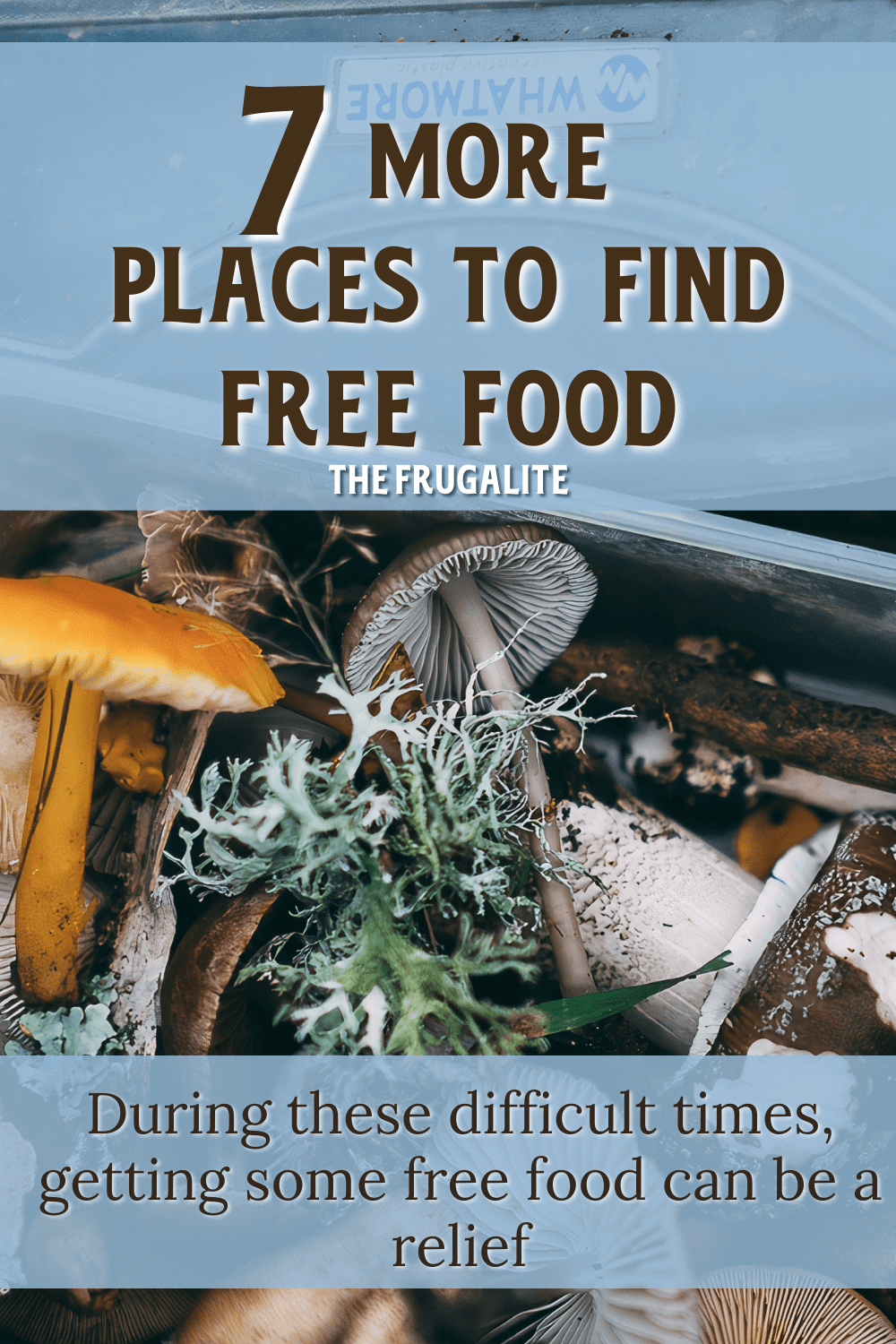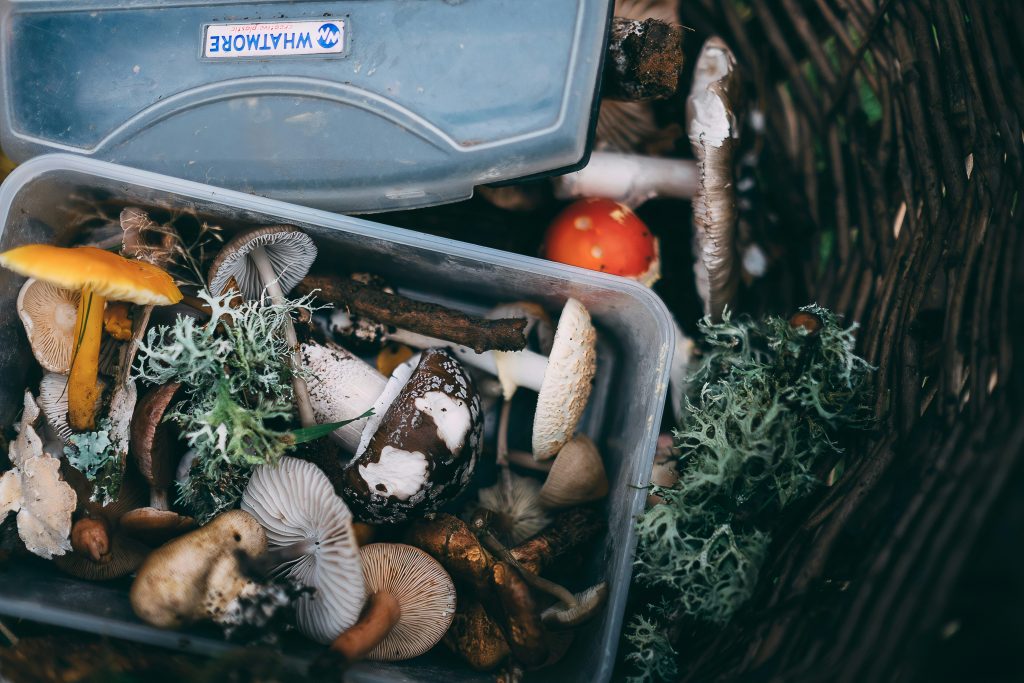(Psst: The FTC wants me to remind you that this website contains affiliate links. That means if you make a purchase from a link you click on, I might receive a small commission. This does not increase the price you’ll pay for that item nor does it decrease the awesomeness of the item. ~ Daisy)
By the author of the FREE online course Growing Self-Sufficiency: The Whole Picture
It’s all in the news these days that people are facing a squeeze when it comes to buying food. In our area, one example says it all: butter has almost doubled in price in the past couple of years. Yes, almost doubled! Extend that out to all other items, and you get the picture: where is all of this extra money supposed to come from to buy food to eat?
In support of Frugalites everywhere, I thought I would put my thinking cap on and focus on places where I have found free food in the past or places that I am aware of could have it. This article is the second part of a two-part series on tips to help you find free food when needed.
Now, remember what they say about that free lunch? Well, the same could probably be said about free food in general. So, remember, dear Frugalite, that many of these ideas will require either some time or elbow grease to reap the benefits. If you have some suggestions from your own neck of the woods, please add them at the end of the article in the comments!
Farmers’ Markets
If you live in an area with a farmer’s market, it pays to go out and see who has a booth there. Does anyone seem short-staffed? Have a chat with them. Could they use some help setting up or breaking down the booth for some of their produce? You could also ask if there are any opportunities to glean fields. If you don’t have a car, perhaps you have an interested friend who could drive you there.
Certainly, at the end of the market day, there are some great deals to be had, as the farmers don’t want to take this produce home. I once got an apprenticeship and a bunch of free honey just by chatting with a beekeeper at a totally urban farmer’s market. I did not own a car at the time, and he was willing to pick me up at a subway station to take me to his sites and assist him. During harvest time, many small-scale beekeepers are in a similar situation. It never hurts to ask!
Community Health Center
Here in our province, community health centers are designed to help vulnerable populations of people with health and other challenges, such as accessing fresh food. Our own community health center has a community garden (more below on this!), group cooking classes where you get to keep what you make, and people in need can access some gift cards to buy food. In addition, there is a “bring one, take one” style food bank in the lobby and a free clothing service in the building.
Community Gardens
Using a bit of elbow grease, you can get a lot of free food this way. Even if you can’t afford the plot fee, you may be able to freelance and help other gardeners in exchange for some produce. If you like zucchini this time of year, you need never go hungry! If you are skeptical of that claim, check out my article on “All Day” zucchini eating here. Many gardens will waive the user fees for people in need. Don’t be afraid to check out what’s possible, even later in the season.
Bartering
I saw an ad online for some good-looking garlic for a great price. When I replied, the farmer asked me if I was willing to trade for some of my famous chocolate chip cookies. It turns out he had seen on social media that I used to sell them. We have arranged a trade: one head of garlic for one cookie, a straight-up trade. As I don’t mind baking, this is a great deal for me. Organic garlic often goes for $3 or $4 a head around here. I will also get some to share with our community garden members. 24 cookies for 24 heads of garlic. The price is less than $1 per head, a fraction of what you would pay anywhere else, and the quality is much higher.
Social Media
Before I sat down to write this article, I scanned my social media feed in the market area. I saw a few offers of free food. Many folks will do this during the harvest season: free berries, free zucchini, etc. If you’re willing to go pick, you can get some good food. If they do charge, the cost is a fraction of what it would cost you at the grocery store.
Foraging
I am able to safely identify and eat a number of plants on my half acre. The first step to safe foraging is to own a reliable plant identification guide. I own two. I found that using these guides was a learning curve and challenging at times. It is also best to have a mentor to go out with and practice with. In times of need, I know several plants that I could go out and identify for food. These also supplement what I grow for myself in my garden. That is a great feeling!
Your Own Fridge
“Wait a second!” you might be saying. “I paid for that food; it’s not free!” However, what I’m asking you to do is take a second look. In our community garden project, one of our goals is to encourage everyone to do just that: take a second look at what you’re throwing out or composting. Traditionally, many edible parts of plants may not be used. Last night, for example, I sautéed large kale stems that would not be pleasant to eat raw in large chunks. However, thinly sliced like celery, they were delicious.
This also works raw in slaws and salads. I also eat carrot tops, beet greens, and stems in the same way. Last night, I threw the last of a “surprise” giant zucchini into my sauté. While it was a bit seedy, I just cut out that part and chopped up the rest. Waste not, want not!
Free Food Can Help Pay the Rent
During these difficult times, getting some free food can be a relief. Could you see yourself trying any of the tips offered here to access free food? Do you have one you can share with us? Please tell us in the comments below.
About Colette
Colette is passionate about sharing her knowledge of thrifty living and self-sufficiency. She has developed her skills in self-reliance living in the suburbs, the city, and more recently, on her own Half-Acre Homestead. Colette lived five years completely off-grid and without running water in an eight by 24 foot tiny home while designing and building her own 18 by 24-foot eco-cabin. Her website, Half Acre Homestead is attracting followers from around the world who want to become more self-sufficient. Colette invites you to stop by the Homestead and check out all of the great resources including the practical How To Guides, A Tiny Home Resource Center and her organic gardening stories on her blog. She shares her wholistic model (body/mind/spirit) for achieving self-sufficiency in her Free Course, “Growing Self-Sufficiency: The Whole Picture.” Stop by the Homestead today to register free of charge!












7 thoughts on “7 More Places to Find Free Food”
A lot of people plant apple and pear trees and just let the fruit drop. They pay a lawn service to clean up the mess or let birds eat it. Ask if you can pick the fruit as it ripens. You might offer to pick it “on shares”. Sometimes you get fruit. Sometimes they tell you “no” but it is worth trying. I got several pounds of nuts by asking if they would like me to pick up the fallen ones. They didn’t want to be bothered by either picking or shelling. I shelled while watching TV.
Hi Mary, This is a great idea! Thanks so much. Several pounds is a real “windfall” (no pun intended ha ha ha!) and would add substantially to anyone’s pantry. I love how you shell them while relaxing and watching TV…a win win situation. Much appreciated!
In the US there is the federal SNAP program — short for Supplemental Nutrition Assistance Program. It is enormous, complex, full of rules at both the federal and state level … and fortunately summarized in considerable detail in this wikipedia article
https://en.wikipedia.org/wiki/Supplemental_Nutrition_Assistance_Program
There are many other search hits that come up if one is so inclined to explore such detail.
I checked to confirm that SNAP was not previously mentioned in either Part 1 or Part 2 of this topic.
–Lewis
Hi Lewis, Thanks so much for this and for checking both articles. In Canada, there is no separate food (stamp) program. It is always tied to receiving social support monies, which are sometimes divided into shelter expense and personal needs (would include food and everything else) *this depends on the program. This is just an example!*. Otherwise, folks go to the food bank. I tend to stay away from adding details about the American programs, as I really don’t know anything about them, and local information, such as knowing someone who knows…., is generally much more accurate. I read through most of the article and was pleased to see that there are some info on who qualifies and how to apply. That’s great. Much appreciated!
This is not a new concept but I’m going to share it anyway since I still see so many people in need of the message.
If you want to be able to eat when you have almost no money, learn to cook, and especially learn to cook things like beans, peas, lentils, rice. Learn to season them well so you truly enjoy them.
I can’t tell you how many times I’ve seen people turn their noses up at these types of things when they are supposedly hungry. Meanwhile I grew up eating them. If you can make use of them you will hardly ever truly go hungry. Worried about nutritional balance? Yes, that’s important, but a dollar store multivitamin will get you through till you earn more money and in the meantime you can use the other ideas in this article.
Hi Redbranch, Unfortunately, I have also heard that many folks do not want these precious items from food banks: lentils, beans etc. It is so sad how people have been socialized AWAY from healthy eating by corporate interest in upselling expensive and UNHEALTHY processed foods. I think there are two sides to this coin: folks have never eaten these and have no idea how to cook them, and their own tastebuds have been acclimatized to the heavy fat, sugar and salt of the processed foods so (sadly) that these basic staples seem (I don’t know) dull, boring, foreign, etc.
I agree that spreading the word on this is key. I know that this website does a great job in sharing recipes that will hopefully convert folks to cooking with staples, to their own significant benefits! Much appreciated, as always!
A fair amount of the problem is simply that people don’t know quite how to work with some these foods. My own late mother, who was a homemaker for most of her life, was good at making inexpensive meals from basic ingredients; and some of that has rubbed off on me, as I mostly eat stuff I’ve brought home from volunteering at my local food pantry (mostly “mystery meal” cans of food that have lost their labels and torn bags of dried beans/peas/rice along with punctured packages of frozen meat, as safety and sanitation rules forbid giving food in breached or unlabeled packaging out to clients even when we know it’s safe) these days. In the early years of her marriage as she was giving birth to my older brothers and myself, the family wasn’t exactly flush with cash (especially since this was mostly during the economic malaise and stagflation of the 1970s and early 1980s, and nobody around us—including my respectably employed father’s coworkers—was particularly wealthy either), so she had to learn fast how to feed us all on a tight budget.
To get back to the subject at hand, while Mom was good at working with most of these inexpensive foods, there were three she just never quite mastered:
1. lentils
2. pinto beans
3. salmon
Had our family been desperate and hungry enough, and these been the only foods we could get, I suppose she might have come up with a way to make them palatable; as the matter stood, however, she was able to get other stuff she (and we) liked cheaply enough that she never had to. Interestingly, these three specific foods are also remarkably common in the monthly shipments from Second Harvest we receive at the food pantry where I volunteer (although curiously, we’re currently out of lentils and down to our last box of pinto beans, there not having been any of those in the last several shipments).
While Mom and I knew how to make decent split pea soup (which goes well with just about any kind of meat) and could boil lentils into a soft and edible mush in the same manner, she always complained that lentils in any form tasted like ashes and she couldn’t find any way to make them taste like anything else. According to the Bible, Jacob managed to talk his brother Esau into trading his birthright for a bunch of lentil soup or stew or some such, which suggests he knew how to cook them in some manner as to make them delicious. Whatever recipe he (and probably his mother Rebecca) used, however, neither Mom nor I ever figured it out for ourselves.
Mom likewise never liked pinto beans, although mostly just because they had a bland and weird taste that didn’t seem to combine well with anything else. My first experience with eating any was during a church summer camp when I was a teenager, and my opinion of them was about as low as hers, though I ate them anyway since I was hungry and they were what was available. In the years after she passed away, I eventually discovered that pinto beans are considerably more palatable if combined in roughly equal portions with rice and with copious amounts of salt. (This discovery came from one of those “mystery meal” cans from the food pantry that turned out to contain this exact combination, you see.)
As for salmon, it’s a lot like tuna (which Mom could and did regularly get inexpensively in bulk from the grocery store), except for tasting a lot blander (and slightly bitter) and not combining well with mayonnaise at all. So, why eat a kind of fish you don’t like and can’t easily prepare when you can get the kind you do like and can easily prepare at about the same price, right? After he struck out on his own as an adult, my eldest brother did eventually find a fairly good recipe for making salmon croquettes that Mom and I agreed tasted pretty good, but neither of us ever ate salmon very often even then, since the recipe required a lot more effort (and cleanup afterward) than just mixing tuna with mayo and slathering it on bread to make a sandwich.
One other kind of food Mom never fed us that we receive quite often at the food pantry that almost nobody actually seems to want is chick peas, a.k.a. garbanzos. Mind, Mom and I both ate—and enjoyed—hummus, in which mashed-up chick peas/garbanzos are in fact the principal ingredient, but there’s a reason why that stuff’s considered “hipster food” (which is not very popular in rural North Carolina) and even said hipsters to whom it appeals usually prefer just to buy hummus (even though it’s sold at a hefty markup over the raw ingredients) rather than make it for themselves. Evidently, making hummus in any significant quantity requires a special expensive kind of blender and is a rather labor-intensive process that yields only small amounts in return for an individual’s efforts; so it makes more sense to let food-processing factories mass-produce it instead.
So… there you have four foods you might well be able to get cheap or for free that my family didn’t eat even in its leanest years (i.e. especially during the 1970s). In their place, what we did eat—respectively—is four other relatively inexpensive foods you can probably get cheap or free:
1. split peas
2. baked beans
3. tuna
4. peanut butter
All of these have been available at one time or another at the food pantry where I volunteer, although we’re currently out of split peas and lentils for some reason, tuna is only available in limited quantities while canned salmon is plentiful, and baked beans are even more limited whereas we do still have enough one-pound bags of pinto beans to give each of our clients for a little longer while they last. (We also do have enough peanut butter to give a jar each to every one of our clients at present, however, while we’ve been out of both canned chick peas and bags of dry garbanzo beans for months now.)
The upshot of all this: were my family living on as relatively tight a budget as it was back in the 1970s, we probably could still muddle through the present on cheap and free food, though our diet might be a little different. A lot of the inexpensive foods you mentioned (beans, peas, lentils, rice) are actually more expensive now (relative to income) than they were back then, but back then (when we lived in Minnesota and—for a few years—Wisconsin) my family also weren’t getting anything from a food pantry the way we could nowadays here in rural North Carolina. On the whole, therefore, I’d say the struggle to feed the family would be about the same now as it was back then.
Moreover, if we still couldn’t do anything with lentils, pinto beans, salmon, chick peas, etc.? We could always give or trade them to neighbors, friends, and associates who could. At that food pantry where I volunteer, something I occasionally clarify to clients (especially if they’re being overly picky or “turning up their nose” as Redbranch here says, and/or if they’re sharing their ride with other clients) is that if they really don’t like some of the stuff we’re giving them for any reason, there’s no law forbidding them from giving or trading it away to anyone else.
So if what you can get for free (using the options in this post and the one preceding it) doesn’t happen to suit your family (especially your notoriously picky children, if you have any) for some reason? Go with the fourth option on this list and barter away the free stuff your family doesn’t want for something it does (in the long run, even just some good will between friends can be worth the trade). Chances are at least one of the people you know—even in passing—can use it; e.g. though neither my family nor much of anybody else around here seems to like lentils, my family is friends with a Jewish family at a Bible study that knows a way to prepare them it likes and would be more than happy to take them off our hands.